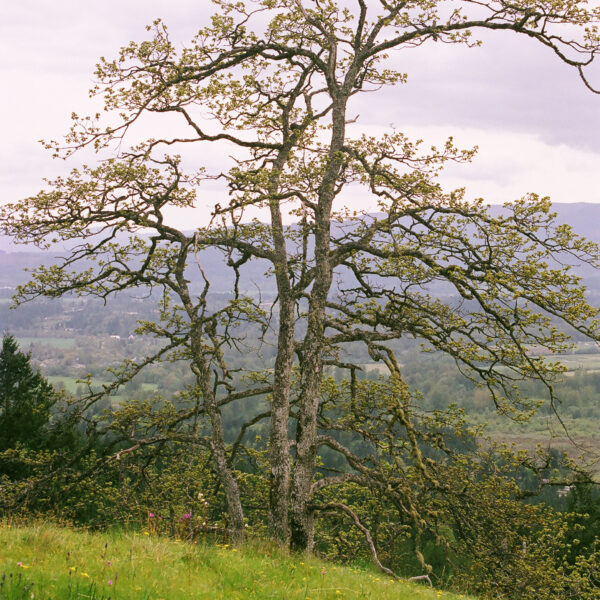Garry Oak
Quercus garryana Dougl.

overview
Heavy-limbed tree growing 12 to 35 m tall, with main stem 60 to 270 cm in diameter, though often short and crooked in rocky habitats. Bark is light grey, with thick furrows and ridges. Leaves are alternate, deciduous, deeply round-lobed typical oak leaves to 12 cm long, shiny dark green above, greenish-yellow and brown-haired below, turning dull yellow-brown in fall. Male and female flowers are tiny and inconspicuous, borne in separate inflorescences on the same tree but are self-incompatible. Male flowers are hanging catkins female flowers are single or small clusters. Flowers at same time as leaves appear. Fruit is an acorn found singly or in pairs, 2.5-3 cm long ovoid to obovoid, with a shallow cup enclosing less than third of the acorn (Elias, 1980; Pojar and MacKinnon, 1994). Photo by Brian Reader.
other names
Oregon white oak, Pacific oak, shin oak
family
Fagaceae
ecological setting
In BC occurs primarily within the rain shadow of the Olympic Mountains and the Vancouver Island ranges. Grows at low elevations on various sites and soil types. In BC ranges from Comox through the Gulf Islands to Greater Victoria. Isolated occurrence in the lower Fraser Canyon near Yale.
soil texture
Rocky outcrops to deep, rich, well-drained soils. Grows best in the latter.
soil reaction salinity
pH 5-6.5
moisture regime
Moist to dry.
shade tolerance
Shade tolerant as young seedlings, becoming shade intolerant with age.
successional status
Climax species on open, xeric sites. Tends to be out-competed on mesic sites unless maintained by frequent disturbance (i.e. fire).
bec zone subzone status
Characteristic species of Garry Oak ecosystems.
site rehabilitation
Potential reclamation species in the drier phase of the Coastal Douglas-fir Biogeoclimatic Zone.
wildlife
Acorns consumed by numerous species of animals.
landscaping
Valued species, particularly older specimens with intricate branching patterns. Widely used as an ornamental in the Pacific Northwest for spacious lawns, parks and avenues.
first nations
Wood used for combs and digging sticks and burned as fuel. Acorns eaten after soaking to remove tannins. Bark infusions used to treat tuberculosis and other ailments (Turner, 1998).
flowering time
February to May
fruit ripening time
Late summer
seed collection time
September to October
crop intervals
Two to three years
no seeds per kg
165 - 225
seed viability
Empty or insect damaged seeds common
collection and abstraction
Ripe acorns are best collected by hand-picking into picking bags (Banerjee et al., 2001) or by tapping off branches with a bamboo pole onto tarps. Avoid collecting mature fallen acorns to which the caps are still attached. Separate insect-damaged from sound seeds by presence of bore holes, and by floating off unsound acorns in water.
seed storage
Seeds should be sown as soon a possible in the fall. If storage is necessary it should be for as short a time as possible. Store under moist conditions in a refrigerator (do not freeze) until sowing. Fresh acorns germinate rapidly under warm moist conditions. Soaking in water for one to several days improves germination (Jebb, 1995; Buis, 1996).
fruit seed dormancy treatment
No dormancy exhibited, thus no treatment required.
vegetative propagation
Possible but not recommended for practical propagation operations.
additional info and photos
For further information about growing Garry Oaks, please see Growing Oak Seedlings in Small Containers and Forestry Facts: Guidelines for Establishment of Oak Seedlings.
For more information and pictures, visit the E-Flora BC website at www.eflora.bc.ca.